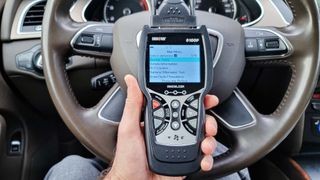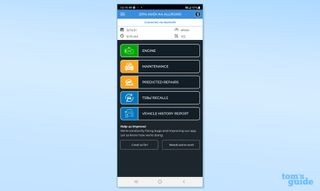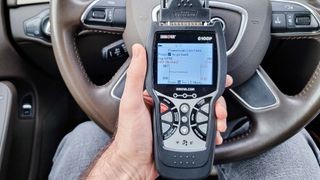The Innova 6100P OBD2 scanner is making waves in the DIY automotive repair community, promising features typically found in higher-end devices at a mid-range price point. This review delves into the specifics of the Innova 6100P, examining its design, functionality, ease of use, and overall performance to determine if it lives up to the hype as a versatile and valuable tool for car diagnostics. For those seeking a reliable and feature-rich OBD2 scanner, understanding the capabilities of the Innova 6100P is crucial.
Design and Build Quality of the Innova 6100P
The Innova 6100P immediately impresses with its compact and ergonomic design. Measuring just 7.2 x 3.4 x 1.1 inches and weighing a mere 6.5 ounces, this OBD2 scanner is remarkably portable and comfortable to handle. The thoughtfully designed case includes finger cutouts, enhancing grip and usability during vehicle diagnostics. Compared to bulkier scanners, the Innova 6100P’s small footprint is a significant advantage, making it easy to store in a toolbox or glove compartment.
The 2.8-inch color display, while not as expansive as some premium scanners, effectively presents diagnostic information. The screen is bright and clear, ensuring readability in various lighting conditions. Furthermore, the inclusion of LED indicators for I/M Readiness tests provides quick visual feedback: green for pass, yellow for pending issues, and red for permanent faults. This intuitive system simplifies the process of assessing vehicle emissions readiness.
The Innova 6100P features a nine-button interface that is designed for efficient navigation. Dedicated buttons for fault codes, system status, live data access, and code erasing streamline the diagnostic process. While the buttons require a firm press, this tactile feedback ensures deliberate operation, minimizing accidental inputs.
Functionality and Features: Handheld and App-Enhanced Diagnostics
The Innova 6100P distinguishes itself by functioning effectively as both a standalone handheld OBD2 scanner and a Bluetooth-enabled device that connects to the Repair Solutions 2 mobile app. This dual functionality expands its capabilities significantly beyond basic code reading.
As a handheld scanner, the Innova 6100P provides essential diagnostic functions directly on its screen. Users can quickly read and clear fault codes, check system status, and access live data streams without needing a separate device. This standalone capability is ideal for quick roadside checks or when app connectivity isn’t convenient.
However, the true power of the Innova 6100P is unlocked when paired with the Repair Solutions 2 app via Bluetooth. Available for both iOS and Android devices, the app mirrors the scanner’s display and adds a wealth of advanced features. These include access to technical service bulletins (TSBs), problem severity assessments, and predictive failure analysis, providing users with a more comprehensive understanding of vehicle issues.
A standout feature of the Repair Solutions 2 app is its repair assistance. It provides step-by-step repair guidance and, crucially, links to parts suppliers with pricing information. This integration of diagnostic data with repair resources is invaluable for DIY mechanics, streamlining the troubleshooting and repair process. This level of support is not commonly found in consumer-grade OBD2 scanners, setting the Innova 6100P apart from competitors.
Setting Up and Using the Innova 6100P
Setting up the Innova 6100P is straightforward, although Bluetooth pairing adds a slightly more involved step compared to basic plug-and-play scanners. Connecting the scanner to the vehicle’s OBD port is simple, and the 72-inch cable offers ample length for comfortable use even while working under the hood.
For firmware updates and printer connectivity, the Innova 6100P includes a mini USB port. It’s worth noting that the scanner relies on the vehicle’s power supply for operation, lacking an internal battery. Pairing the scanner with the Repair Solutions 2 app via Bluetooth is a quick process, adding only a couple of minutes to the initial setup but unlocking the scanner’s full potential.
The Innova 6100P package is focused on the essentials, including the scanner and connection cable. However, Innova provides excellent online support resources, including a comprehensive downloadable manual and a library of repair videos. Customer support is readily accessible via email, online chat, or a toll-free phone number, offering assistance six days a week.
Performance in Vehicle Diagnostics
In terms of performance, the Innova 6100P proves to be a responsive and reliable OBD2 scanner. It quickly connects to the vehicle’s computer and accurately reads diagnostic data. The scanner successfully identified and cleared fault codes during testing, including turning off the check engine light after resolving a simulated sensor issue. The I/M Readiness test function provided immediate emissions status feedback.
While the Innova 6100P covers a wide range of diagnostic functions, it’s important to note some feature differences compared to other Innova models. For example, it lacks the cylinder balance test found in the 5310 model. However, it does provide essential system checks, including alternator and battery testing through the vehicle’s computer, and offers oil light reset functionality.
The Bluetooth connectivity and Repair Solutions 2 app enhance the diagnostic experience significantly. The app’s extended Bluetooth range allows for convenient remote diagnostics, and its ability to provide service interval reminders and predictive maintenance suggestions adds proactive vehicle care capabilities. The app’s detailed reports and repair guidance further empower DIYers to tackle automotive maintenance with greater confidence.
Final Verdict: Is the Innova 6100P the Right OBD2 Scanner for You?
The Innova 6100P OBD2 scanner strikes an impressive balance between handheld convenience and advanced app-driven features. Its compact design, ease of use, and comprehensive diagnostic capabilities make it a strong contender in the mid-range OBD2 scanner market. The inclusion of the Repair Solutions 2 app, with its repair guidance and parts sourcing features, elevates the Innova 6100P beyond basic code readers, offering substantial value to DIY mechanics and car owners alike.
While it may not have every feature available in top-of-the-line professional scanners, the Innova 6100P provides an exceptional set of tools for diagnosing and addressing vehicle issues. For those seeking a versatile, user-friendly, and feature-rich OBD2 scanner without breaking the bank, the Innova 6100P is a highly recommended choice. It empowers users to not only understand their vehicle’s problems but also take informed steps towards effective repairs.
Innova 6100P: Key Specifications
| Feature | Specification |
|---|---|
| Size: | 7.2 x 3.4 x 1.1 inches |
| Weight: | 6.5 ounces |
| Live data: | Yes |
| Display: | Color, 2.8 inches |
| Keys: | 9 |
| Bluetooth & app: | Yes |
| Handheld: | Yes |
| Warranty: | 1 year |




